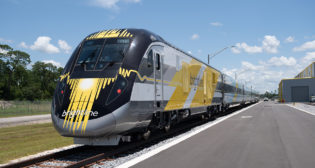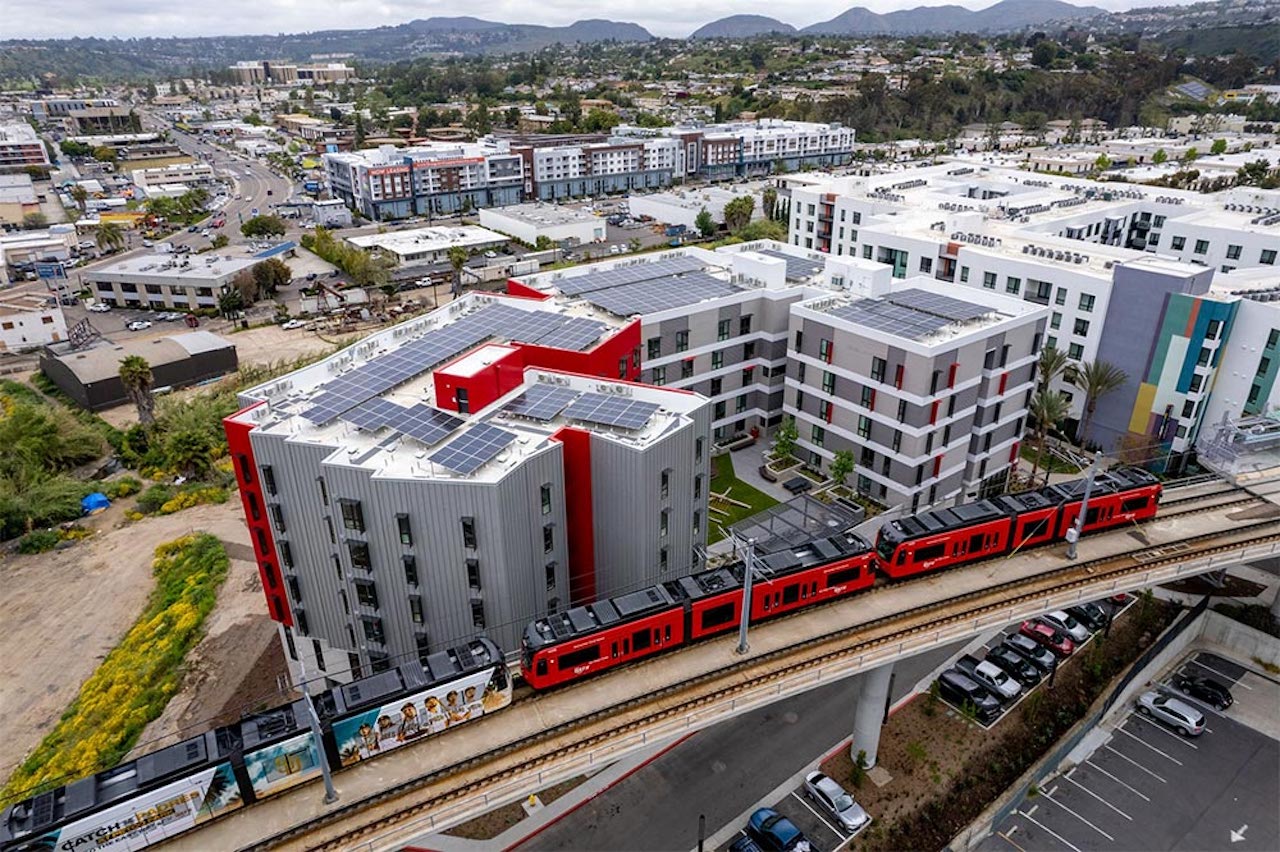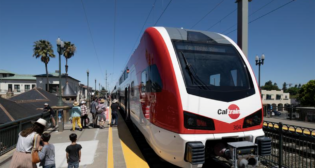
Transit Briefs: San Diego MTS, OCTA, LA Metro
Written by Carolina Worrell, Senior Editor
(San Diego MTS)
Affirmed Housing and the San Diego Metropolitan Transit System (MTS) celebrate the completion of a new transit-oriented development. Also, the Orange County Transportation Authority (OCTA) completes its 2024 Climate Adaptation and Sustainability Plan (CASP); and LA Metro releases its Final Environmental Impact Report (EIR) for the Eastside Transit Corridor Phase 2 project.
San Diego MTS
Affirmed Housing and MTS on April 30 announced the completion of ShoreLINE, a new 100% affordable, transit-oriented housing development for households earning between 30% and 60% of the area median income (AMI).
The new $62.6 million affordable housing community is located at the Grantville Transit Center on Alvarado Canyon Road. A grand opening celebration was held on April 30 with Mayor Todd Gloria, MTS Board Chair and San Diego City Councilmember Stephen Whitburn, Councilmember Raul Campillo and regional housing leaders in attendance.
According to MTS, ShoreLINE was developed to “support residents’ holistic healthy living and wellbeing.” The new, seven-story building features 126 studio, one-, two- and three-bedroom apartment homes and a wide array of amenities and services “to foster community engagement and enhance quality of life goals.”
Shared indoor amenities include laundry facilities on every level, bike storage, a computer lab, kitchen and a community room with gathering space. ShoreLINE’s outside space includes parking, an expansive courtyard, outdoor gardens and additional gathering spaces with built-in seating, an enclosed tot-lot play area and a barbecue station. A large paseo leading to the main entrance and several paths through and around the building connect to the transit station to encourage pedestrian and bike activity.
Residents also have exclusive access to onsite supportive services, such as after-school programs for children and adult education programs that focus on health and wellness, skills and career building, human services and more.
ShoreLINE, the agency says, is part of a larger plan to redevelop MTS’ top-tier park and ride locations into transit-oriented developments. The site replaces an existing MTS parking lot, with the affordable development situated on the western half and a separate, neighboring, market-rate development for students, developed by Greystar, located on the eastern side of the lot.
Affirmed Housing worked closely with the team at Greystar to master plan the overall site in a way that was most beneficial to MTS’s goals as landowner. As part of ShoreLINE’s development, Affirmed Housing leveraged various types of funding and tax credit resources, and although the project’s plan adhered to the land use guidelines governing the site, the company still engaged and worked closely with the San Diego Development Services Department “to ensure a smooth process and engaged in community outreach to neighbors and planning groups.”
ShoreLINE is one of four affordable housing projects that stem from an Affirmed Housing and MTS partnership. The team recently broke ground on SkyLINE, located at the Rancho Bernardo Transit Station, which will include 100 affordable apartment homes and roughly 14,000 square feet of commercial space that will be Affirmed Housing’s new corporate headquarters. Other top-tier properties MTS is in the process of redeveloping include:
- Rancho Bernardo Transit Station.
- Palm Avenue Trolley Station.
- Spring Street Station.
- 12th & Imperial Transit Center.
- El Cajon Transit Center.
- E Street Transit Center.
- Beyer Boulevard Transit Center.
Additionally, MTS has existing transit-oriented developments at the Morena Linda Vista Station, Grossmont Station, 62nd Street Station, 47th Street Station and Grantville Station with 1,155 completed and occupied apartment homes with an additional 100 currently under construction.
Affirmed Housing’s development and design partners on ShoreLINE include MTS, San Diego Housing Commission, the California Department of Housing and Community Development (HCD), the City of San Diego, Boston Financial, Cal Bank & Trust, Banner Bank, Studio E Architects, HA Builder Group, Compass for Affordable Housing, CONAM Management Corporation and more.
“Transit-oriented developments are smart investments that help pave the way for healthy cities and citizens, and ShoreLINE goes above and beyond to demonstrate exactly that,” said Affirmed Housing President Jimmy Silverwood. “This project provides hard working families and individuals with more than just a roof over their head. It recognizes their contribution to society and gives them the access and resources to live their best lives. Affirmed Housing is proud to partner with MTS in developing impactful, forward-looking projects that help make San Diego one of the best places to live.”
“ShoreLINE is another example of how MTS is repurposing park and ride locations to provide much-needed relief to our region’s housing crisis,” said Stephen Whitburn, MTS Board Chair and San Diego City Councilmember. “This transit-oriented development has proven to be a successful opportunity for the public and private sectors to partner to offer affordable housing along with sustainable transit options for San Diegans.”
OCTA
OCTA recently completed its comprehensive 2024 Climate Adaptation and Sustainability Plan (CASP). “Building upon OCTA’s long-standing commitment to environmental stewardship, the plan sets a framework for addressing the impacts of climate change on the county’s transportation system and is aligned with statewide sustainability goals,” according to the agency.
OCTA’s CASP (download below), the agency says, “was developed with the vision to champion sustainability while adapting to an evolving environment, ensuring the delivery of reliable and balanced transportation choices.” The plan details strategies to address climate change’s multifaceted challenges, including greenhouse gas (GHG) emissions, climate-related hazards to facilities, and enhancing OCTA’s adaptive capacity to protect the community.
“As stewards of taxpayers’ dollars and our environment, the completion of the OCTA’s Climate Adaptation and Sustainability Plan will be a guide for us to outline actions to achieve effective climate goals,” said OCTA Chair Tam T. Nguyen. “I’m also pleased that the plan will help us create a path to a greener and more resilient tomorrow.”
According to the agency, environmental stewardship is built into the fabric of all of OCTA’s initiatives and the agency has been a leader and innovator in this space for decades. These efforts, among others, underscore OCTA’s pivotal role in combating climate-related challenges.
- “More than 20 years ago, OCTA adopted its first Long Range Transportation Plan (LRTP), which lays out an agency-wide strategy to address the growing transportation needs of Orange County’s population while ensuring that transportation options are sustainable, equitable, and innovative.
- “Two environmental programs were integrated into OCTA’s 2006 voter-approved Measure M sales tax: the Environmental Mitigation Program and Environmental Cleanup Program. These programs ensure sensitive habitat and wildlife in the region are protected in their native state and help improve overall water quality in Orange County.
- “Since 2011, OCTA has monitored and reported GHG emissions, exemplifying its dedication to environmental leadership.
- “In 2020, OCTA adopted its Zero-Emission Bus Rollout Plan, which commits the agency to transitioning to a 100% zero-emission bus fleet by 2040.
- “In 2021, OCTA, in partnership with Caltrans, developed the Rail Defense Against Climate Change Plan, which identified climate-change-related opportunities and challenges along OCTA’s rail line between Fullerton and San Clemente.
- “In 2021, OCTA issued its Natural Hazard Mitigation Plan to support current OCTA emergency and crisis management plans and strengthen the agency’s preparedness in the face of natural hazards, including climate change.”
Building upon OCTA’s existing efforts, the CASP identifies 34 unique assets, evaluating their vulnerability against seven climate hazards:
- Air quality.
- Precipitation changes and drought.
- Flooding.
- Severe storms and extreme weather.
- Storm surges.
- Temperature changes.
- Wildfires.
Using impact and adaptive capacity scores, OCTA says its facilities, programs and services have been assessed to prioritize adaptation strategies, “ensuring that future disruptions to the public and passengers, increased operations and maintenance costs, and operational disruptions are minimized.”
The plan presents adaptation strategies for OCTA’s consideration tailored to specific climate stressors. In parallel, OCTA has also refined its GHG inventory methodology, setting a solid baseline for tracking progress. Innovative strategies outlined include transitioning to a cleaner fleet and implementing energy efficiency measures across facilities.
With exploratory targets and recommended strategies outlined, OCTA says it will now focus on goal setting, financial analysis, and feasibility studies to drive these strategies forward. “OCTA will continue engaging with internal and external stakeholders to refine these pathways for a sustainable transit future,” the agency said.
LA Metro
LA Metro announced April 30 that it has prepared the Final EIR for the Eastside Transit Corridor Phase 2 project, an approximately 9-mile extension of the Metro E Line from its current terminus at Pomona Bl and Atlantic Bl in East Los Angeles all the way to Whittier.
Approximately 722,000 people live in this area, which is one of the fastest growing areas of Los Angeles County. It’s also a major hub for employment opportunities, particularly in the fields of retail (such as Commerce Citadel, as well as numerous warehouses serving retailers), manufacturing, and healthcare. Approximately 274,000 people currently work here, and it’s expected to grow by 25% by 2042.

This rail line, LA Metro says, would bring a much-needed connection into Southeast Los Angeles and the Gateway Cities by offering a one-seat ride to downtown Los Angeles and beyond––continuing all the way to University of Southern California (USC) and even Santa Monica. Corridor cities along Washington Boulevard and the East Los Angeles neighborhoods along Atlantic Boulevard will also have better access to regional transit, such as the Metro A and B Lines, Montebello Bus Lines and Metrolink, as well as key destinations in the area (think historic Whittier Boulevard and the Citadel Outlets).
The initial project build-out will go to Greenwood Station in Montebello, a 4.6-mile route that includes three miles of light rail transit (LRT) underground, .5 miles of aerial and 1.1 miles of street level transit. It will add three new stations: Atlantic/Whittier (underground), Commerce/Citadel (underground) and Greenwood (street level). The project also includes a Maintenance and Storage Facility (MSF) located in the City of Montebello.
Since the Board approved Lambert Station as the terminus of the full 9-mile project and the 4.6-mile Locally Preferred Alternative (LPA) in December 2022, LA Metro says it has been working with various cities, agencies, and internal departments to address the public’s 900-plus comments from the Draft EIR.
The Final EIR summarizes revisions to the project since the release of the Draft EIR in June 2022. These include improved train access to a proposed maintenance and storage facility in Montebello, as well as design refinements to the rail track crossovers in order to make train operations safer and easier to maintain.
The Final EIR is available here.



